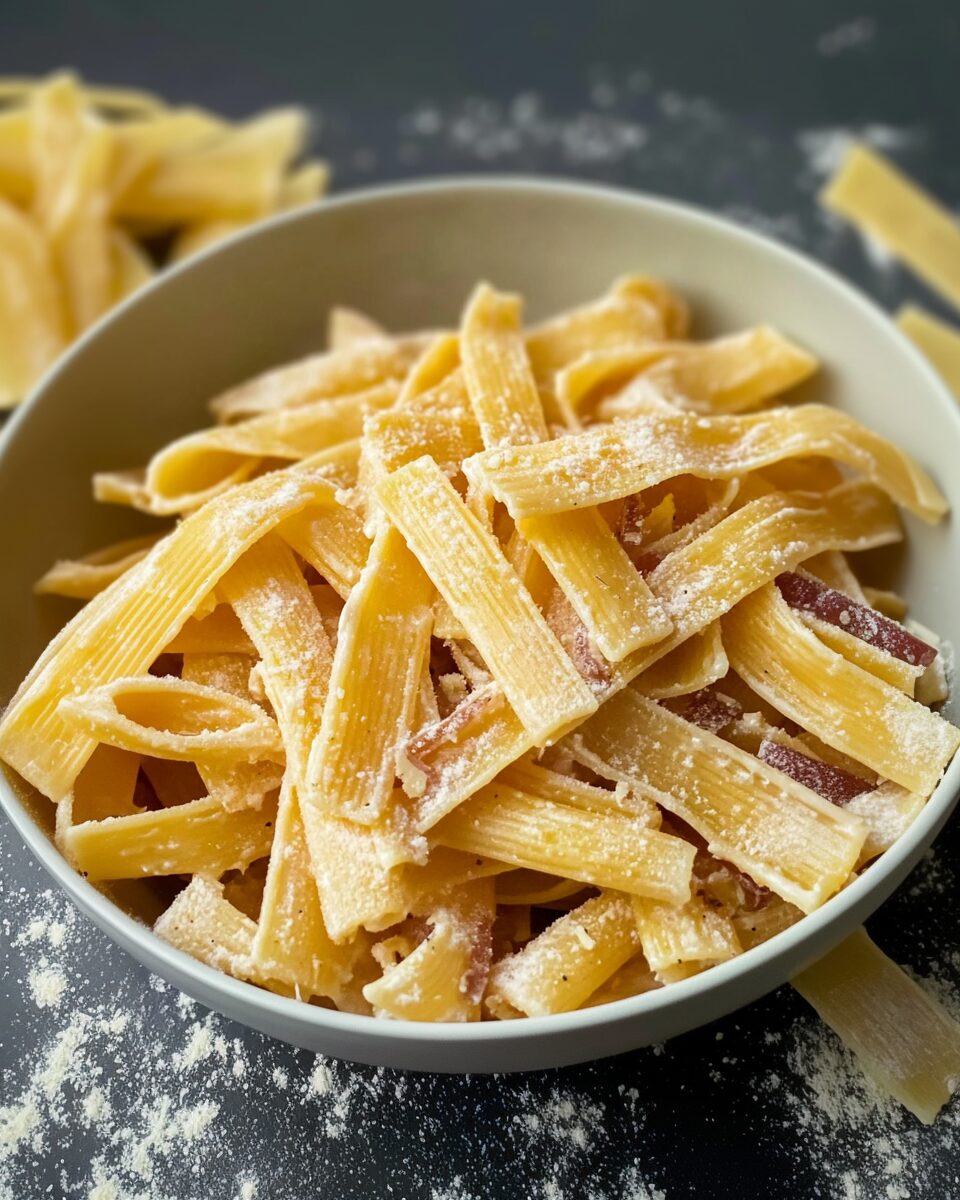Pasta alla Gricia, often referred to as Guanciale Pasta, is a simple yet flavorful Roman dish made with just a few ingredients: guanciale, Pecorino Romano, and black pepper. It’s perfect for a quick, delicious meal that packs a savory punch.
Full Recipe:
Ingredients
-
Pasta (any variety)
-
Guanciale (cured pork cheek)
-
Pecorino Romano (freshly grated)
-
Black pepper
-
Peperoncino (optional for heat)
-
Salt (for pasta water)
Directions
-
Boil salted water for pasta and cook according to package instructions.
-
Meanwhile, cook chopped guanciale in a pan over medium heat until crispy.
-
Add the cooked pasta directly into the pan and stir with a bit of pasta water.
-
Off the heat, add grated Pecorino Romano and black pepper.
-
Mix well, serve with extra Pecorino and pepper.
Nutritional Facts
-
Calories: 769 kcal per serving
-
Protein: 27g
-
Fat: 43g
-
Carbohydrates: 77g
The Origins of Pasta alla Gricia
The origins of Pasta alla Gricia trace back to the Lazio region, where Rome is located. This dish is part of a culinary tradition that revolves around the region’s iconic cured meats and cheeses. It was originally considered a peasant dish, enjoyed by farmers and shepherds who used ingredients readily available to them, such as guanciale and Pecorino Romano. Interestingly, the inclusion of tomatoes came much later, and Pasta alla Gricia is often seen as the precursor to other tomato-based Roman pasta dishes like Pasta all’Amatriciana.
Guanciale: The Star Ingredient
At the heart of Pasta alla Gricia is guanciale, a type of cured pork cheek that offers a rich, fatty, and savory profile. Unlike pancetta, which is often used in other Italian dishes, guanciale is made from the pork cheek or jowl, and it’s cured with salt, pepper, and herbs. Guanciale has a unique texture, with a melt-in-your-mouth quality that renders beautifully when cooked, releasing flavorful fat into the dish. This fat forms the foundation of the sauce, creating a luscious and silky texture that envelops the pasta.
Pecorino Romano: The Cheese Component
Pecorino Romano is a firm, salty cheese made from sheep’s milk. It is a key ingredient in Roman cuisine, used not only in Pasta alla Gricia but also in dishes like Cacio e Pepe. The cheese adds a sharp, tangy flavor that balances out the richness of the guanciale fat. When freshly grated and mixed with hot pasta, Pecorino Romano melts slightly, forming a creamy coating that perfectly complements the other ingredients.
The Role of Black Pepper
Black pepper is more than just a seasoning in Pasta alla Gricia; it is one of the defining flavors. The heat and sharpness of freshly cracked black pepper elevate the dish, providing a necessary contrast to the richness of the guanciale and the tanginess of the Pecorino Romano. The black pepper should be added generously, as it imparts a distinct aromatic profile that gives the dish its signature spiciness.
Why Simple Ingredients Create Magic
One of the reasons why Pasta alla Gricia is so beloved is because of the way these few ingredients come together to create a harmonious and deeply satisfying flavor. The combination of the savory guanciale, the salty Pecorino Romano, and the sharp peppery kick is nothing short of magical. The dish doesn’t rely on sauces or complicated cooking techniques, but instead highlights the richness and quality of each ingredient. The success of Pasta alla Gricia lies in the careful balance of flavors and the simplicity of its preparation.
Variations and Regional Differences
While the traditional version of Pasta alla Gricia sticks to the basic ingredients of guanciale, Pecorino Romano, and black pepper, there are variations of the dish that add their own twists. Some people may include a bit of white wine to deglaze the pan, while others might experiment with adding chili flakes for an extra punch. In some regions, Pasta alla Gricia is also made with different types of pasta, though rigatoni or spaghetti are the most common choices. While variations exist, true aficionados argue that the traditional version is the most satisfying and authentic.
Pasta alla Gricia: A Classic Roman Dish
Pasta alla Gricia is one of Rome’s oldest and simplest pasta dishes, yet it carries an incredible depth of flavor. Known as the “ancestor” of all Roman pasta dishes, including the famous Pasta all’Amatriciana, it remains a beloved comfort food throughout Italy. This dish features guanciale (cured pork cheek), Pecorino Romano cheese, and black pepper as the core ingredients. Its beauty lies in its simplicity and the ability to highlight quality ingredients.
Pairing Pasta alla Gricia with Wine
The rich, savory flavors of Pasta alla Gricia pair wonderfully with wines that can cut through its fat and complement its salty profile. A crisp white wine like a Frascati or a light red like a Chianti works well. The acidity in these wines helps balance the dish’s richness while enhancing the earthy flavors of the guanciale and Pecorino Romano. For those looking for a more luxurious pairing, a fine Pinot Noir offers a subtle complexity that elevates the dining experience.
How to Make the Perfect Pasta alla Gricia at Home
While Pasta alla Gricia is a relatively simple dish, making it perfectly at home requires attention to detail. First, ensure you use high-quality guanciale and Pecorino Romano for the best flavor. When cooking the guanciale, avoid rushing the process—render the fat slowly to achieve that crispy, melt-in-your-mouth texture. Additionally, pasta water is crucial for creating a silky sauce that clings to the noodles, so save a cup of it before draining your pasta. Following these small steps will help you achieve an authentic and delicious dish.
Pasta alla Gricia in the Modern Culinary Scene
In recent years, Pasta alla Gricia has gained popularity outside of Italy, appearing on menus around the world. Its simplicity and versatility make it an appealing choice for both home cooks and professional chefs alike. Many restaurants serve it as a part of their Italian menu, and its growing fame has made it a must-try dish for pasta lovers. The dish has also become a go-to comfort food for people looking for a quick yet satisfying meal. Its rich, umami-packed flavor and creamy texture have made it a favorite of those who appreciate traditional Italian cuisine.
Conclusion
Pasta alla Gricia is a testament to the beauty of simple ingredients coming together in perfect harmony. With its rich guanciale, sharp Pecorino Romano, and bold black pepper, this Roman classic offers an unforgettable taste experience. It reflects the essence of Italian cooking—using just a few quality ingredients to create something truly special.






